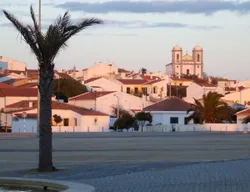

Beja Castro Verde City Features and History
Explore Beja and Castro Verde, two fascinating cities in Portugal. Discover their rich history and unique features that make them worth visiting and learning about.
Castro Verde, Beja
Mycarro AI
May 2, 2025
Introduction to Castro Verde
Nestled in the Alentejo region of Portugal, Castro Verde is a small but vibrant town located within the municipality of Beja. With a population of approximately 4,000 people, Castro Verde is known for its rich agricultural landscape, stunning natural beauty, and cultural heritage. This quaint town offers visitors a chance to experience a traditional side of Portugal, away from the bustling tourist hotspots.
Historical Significance
Castro Verde's history dates back to the Roman era, when it was believed to be an important settlement given its strategic location. The town's name is derived from the Latin word "castrum," meaning castle or fort, reflecting its military significance during ancient times. Its historical roots can be explored through various monuments and archaeological sites, including the nearby Roman ruins of the ancient villa of Pisões and the remnants of the Castro Verde castle.
A Rich Cultural Experience
Castro Verde is famous for its cultural richness, with many traditional festivals and events taking place throughout the year. One of the most significant cultural events is the "Festas de Nossa Senhora da Conceição," celebrated in early December, which attracts visitors from far and wide. During this time, locals participate in processions, music, and dance, showcasing the town's deeply entrenched traditions. Additionally, Castro Verde is home to various local handicrafts, such as pottery and textile arts, which exhibit the region's artisanal skills.
Natural Beauty and Biodiversity
The surrounding landscapes of Castro Verde are characterized by vast rolling plains, golden fields, and the occasional cork oak tree. The area is notable for its rich biodiversity, providing a habitat for numerous bird species, including the endangered Iberian magpie. This makes it an ideal destination for birdwatchers and nature enthusiasts. Castro Verde has been recognized as part of the Important Bird and Biodiversity Areas (IBA) program, emphasizing its ecological significance and commitment to biodiversity conservation.
Gastronomy
No visit to Castro Verde would be complete without indulging in the local gastronomy. The town is well-known for its delicious Alentejo cuisine, characterized by hearty dishes made from locally sourced ingredients. Traditional meals often feature aromatic herbs, olive oil, and bread, providing a taste of the region's agricultural bounty. Staples include "açorda," a bread soup typically made with garlic and eggs, and "migas," a dish made from leftover bread, garlic, and meat. The vineyards surrounding Castro Verde also produce excellent wines, offering visitors a chance to savor the flavors of this remarkable region.
Outdoor Activities
For those seeking outdoor adventure, Castro Verde offers numerous opportunities to explore the breathtaking landscapes. The nearby Natural Park of Vale do Guadiana presents visitors with hiking and biking trails, allowing for an immersive experience among nature. Birdwatching is also a popular activity, as the diverse local species can be observed in their natural habitats. The rolling hills and serene environment provide a tranquil retreat for those looking to escape the hustle and bustle of everyday life.
Conclusion
Castro Verde, Beja, is a hidden gem in Portugal that captivates visitors with its rich history, cultural heritage, and stunning natural beauty. While it may not be as well-known as other cities in the country, its authentic experiences and welcoming atmosphere make it a must-visit destination for anyone exploring the Alentejo region. Whether you are passionate about history, food, nature, or just looking for a peaceful getaway, Castro Verde has something to offer everyone.